NCERT Solutions | Class 11 Chemistry Chapter 11 | The pBlock Elements

CBSE Solutions | Chemistry Class 11
Check the below NCERT Solutions for Class 11 Chemistry Chapter 11 The pBlock Elements Pdf free download. NCERT Solutions Class 11 Chemistry were prepared based on the latest exam pattern. We have Provided The pBlock Elements Class 11 Chemistry NCERT Solutions to help students understand the concept very well.
NCERT | Class 11 Chemistry
| Book: | National Council of Educational Research and Training (NCERT) |
|---|---|
| Board: | Central Board of Secondary Education (CBSE) |
| Class: | 11th |
| Subject: | Chemistry |
| Chapter: | 11 |
| Chapters Name: | The pBlock Elements |
| Medium: | English |
The pBlock Elements | Class 11 Chemistry | NCERT Books Solutions
NCERT Exercises
NCERT Solutions for Class 11 Chemistry Chapter 11, Question 1.
(i) B to TI and
(ii) C to Pb.
Solution.
The aspect common in the variation of oxidation state within group 13 (B to Tl) and group 14 (C to Pb) is that of inert pair effect. As we move down the group (13 or 14), we find that the lower oxidation state becomes more stable. In case of group 13 elements, it is +1 oxidation state that becomes stable while in group 14 it is +2 oxidation state that becomes stable. This behaviour can be understood if we consider the fact that as we move from the 2nd period to the 3rd a d-subshell is added. Similarly, upon moving further down the group there is an f-subshell which is added, f-subshells have a poor shielding effect. As a result, the s-electrons in the heavier elements of the 13th and 14th group are held more tightly and thus, are reluctant to get oxidised. This causes the lower oxidation state to become more stable.|
Element |
Oxidation state |
Element |
Oxidation state |
|
B |
+3 |
C |
+4 |
|
Al |
+3 |
Si |
+4 |
|
Ga |
+1, +3 |
Ge |
+2, +4 |
|
In |
+1, +3 |
Sn |
+2, +4 |
|
TI |
+1, +3 |
Pb |
+2, +4 |
NCERT Solutions for Class 11 Chemistry Chapter 11, Question 2.
Solution.
The higher stability of BCl3 as compared to TICl3 can be explained with the help of inert pair effect which becomes more stable as we move down the group. TI is more stable in its +1 oxidation state and hence TICl3 is not stable as TI shows an oxidation state of +3 in TICl3.NCERT Solutions for Class 11 Chemistry Chapter 11, Question 3.
Solution.
B has an electronic configuration of 1s22s22p1 and undergoes sp2 hybridisation and then bonds with 3 fluorine atoms to yield BF3.
But, inspite of this bonding it remains electron deficient i.e., it does not have 8 electrons around it in the outermost shell; it has only 6 electrons in the outermost shell.
This electron deficiency coupled with the fact that it has an empty 2p orbital which can accept more electrons making it a Lewis acid. (Lewis acids are compounds that can accept electrons)
NCERT Solutions for Class 11 Chemistry Chapter 11, Question 4.
Solution.
BCl3 is an electron deficient compound. Also, it has an empty unhybridised p-orbital which can accept electrons. In presence of water, BCl3 hydrolyses and forms B(OH)3.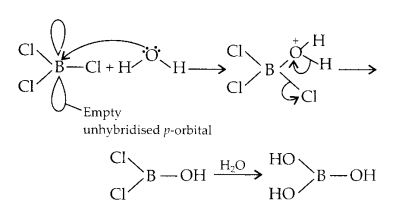
But, when CCl4 is mixed with water, no reaction takes place because carbon neither has any unhybridised, empty p-orbital where it can accommodate electrons from water nor it has empty d-orbital.
CCl4 + H2O ➝ No reaction
NCERT Solutions for Class 11 Chemistry Chapter 11, Question 5.
Solution.
Boric acid – H3BO3 or B(OH)3, is not a protic acid (which are acids that donate protons). But an aqueous solution of boric acid is found to be weakly acidic in nature. This acidic character arises due to the Lewis acid character of boric acid which abstracts a hydroxyl ion from water and leaves free H+ ions which make the solution acidic.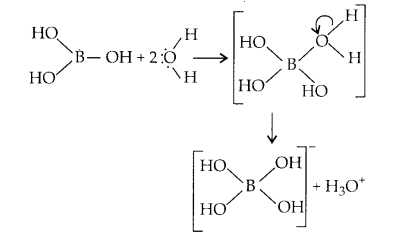
NCERT Solutions for Class 11 Chemistry Chapter 11, Question 6.
Solution.
On heating orthoboric acid above 370 K, it forms metaboric acid, HBO2 which on further heating yields boric oxide, B2O3.NCERT Solutions for Class 11 Chemistry Chapter 11, Question 7.
Solution.
BF3 has a planar triangular structure which arises from the sp2 hybrid orbitals.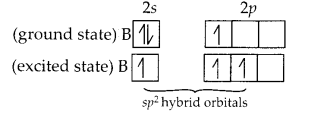
These three sp² hybrid orbitals are directed towards the corners of triangle and BF³ has a trigonal structure.
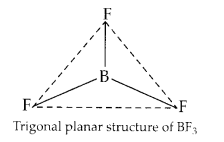
B\({ H }_{ 4 }^{ – }\) may be assumed to be made of a central B atom, 3H atoms and one hydride ion H–.
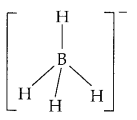
In order to accommodate the 3H atoms and one H– ion, B undergoes sp3 hybridisation yielding four orbitals, 3 of which contain one e– each and one is empty. The fourth, empty orbital accomodates the H– ion. Thus, the structure of B\({ H }_{ 4 }^{ – }\) is tetrahedral.
NCERT Solutions for Class 11 Chemistry Chapter 11, Question 8.
Solution.
Amphoteric substances are those that can react with both acids and bases. Aluminium reacts with HCl to liberate H2 gas as :
NCERT Solutions for Class 11 Chemistry Chapter 11, Question 9.
Solution.

NCERT Solutions for Class 11 Chemistry Chapter 11, Question 10.
Solution.
The resonance structures of \({ CO }_{ 3 }^{ 2- }\) and \({ HCO }_{ 3 }^{ – }\) are :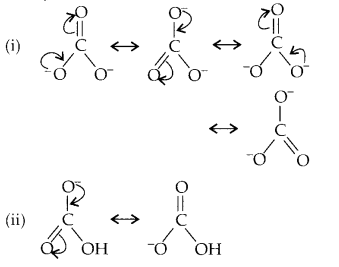
NCERT Solutions for Class 11 Chemistry Chapter 11, Question 11.
(a) \({ CO }_{ 3 }^{ 2- }\)
(b) diamond
(c) graphite?
Solution.
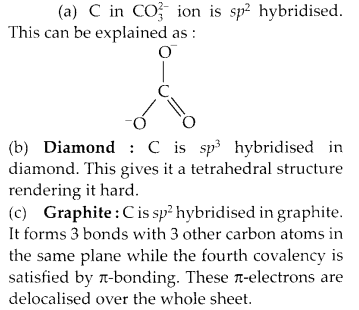
NCERT Solutions for Class 11 Chemistry Chapter 11, Question 12.
Solution.
|
Criterion |
Diamond |
Graphite |
|
Hybradisation |
Sp3 | Sp2 |
| Structure of C | Tetrahedral carbon which gives rise to a 3-dimensional structure. | Planar trigonal which gives rise to a 2-dimensional sheet like structure of carbon. |
| C – C | 154 pm | 141.5 pm |
| Hardness | Due to 3-D structure, diamond is the hardest natural element on the earth. | It is made up of 2-D sheets of carbon which slip over each other. This gives graphite a slippery surface. |
| Electrical Conductivity | Diamond is an insulator |
Graphite is a good conductor of electricity due to presence of delocalized π-electrons.
|
NCERT Solutions for Class 11 Chemistry Chapter 11, Question 13.
(i) Lead (II) chloride reacts with Cl2 to give PbCI4.
(ii) Lead (IV) chloride is highly unstable towards heat.
(iii) Lead is known not to form an iodide, Pbl4.
Solution.
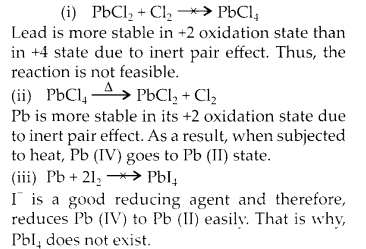
NCERT Solutions for Class 11 Chemistry Chapter 11, Question 14.
Solution.
The bond length in anv compound is dependent on the hybridisation of the central atom. Boron in BF3 is sp2 hybridised which means that the s-character is 33% and therefore, the bond length is shorter. Also due to similar size of both atoms and vacant p-orbital of B, a pπ-pπ back bonding from F to B occurs causes partial double bond character. This further decreases the bond length of B — F. In \({ BF }_{ 4 }^{ – }\), the hybridisation of B is sp3 which means that the s-character is 25% and therefore, a longer bond length.NCERT Solutions for Class 11 Chemistry Chapter 11, Question 15.
Solution.
The dipole moment of any molecule is the vector sum total of each of the dipole moments. In BCl3, molecule, although the B-Cl bonds individually are polar, the resultant dipole moment becomes zero.
We can see that the dipole moments of B-1Cl and B-2Cl produce a resultant which is equal in magnitude but opposite in direction to B-3Cl and hence cancels it out. That is why the net dipole moment of BCl3, is zero.
NCERT Solutions for Class 11 Chemistry Chapter 11, Question 16.
Solution.
AlF3 is insoluble in anhydrous HF but when little NaF is added the compound becomes soluble. On adding BF3 to the above solution, AlF3 is reprecipitated along with sodium tetrafluoroborate.
NCERT Solutions for Class 11 Chemistry Chapter 11, Question 17.
Solution.
Carbon monoxide is a colourless, odourless gas which has a tendency to bind to haemoglobin (the oxygen carrying molecule in blood), forming a complex called carboxyhaemoglobin. This complex is 300 times more stable than oxyhaemoglobin complex and therefore, if once, formed can seriously hamper the oxvgen supply to different organs and ultimately can cause death. This is why CO is said to be so dangerous.NCERT Solutions for Class 11 Chemistry Chapter 11, Question 18.
Solution.
CO2 molecule is transparent to UV radiation but is opaque to IR radiation. Due to this, it allows the UV radiations of sunlight to pass into earth’s atmosphere but does not allow heat, which is in the form of 1R radiation, to move out of earth’s atmosphere. This causes heating of the atmosphere and produces a greenhouse effect.NCERT Solutions for Class 11 Chemistry Chapter 11, Question 19.
Solution.
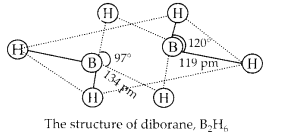
The four terminal hydrogen atoms and the two boron atoms lie in one plane. Above and below this plane, there are two bridging hvdrogen atoms. The four terminal B – H bonds are regular two centre-two electron bonds (2c – 2e) while the two bridge (B – H – B) bonds are different and can be described in terms of three centre-two electron bonds (3c-2e).

Each B atom uses sp3 hybrids for bonding. Out of the four sp3 hybrids on each B atom, one is without an electron shown in broken lines. The terminal B-H bonds are normal 2-centre-2-electron bonds but the two bridge bonds are 3-centre-2-electron bonds. The 3- centre-2-electron bridge bonds are also referred to as banana bonds.
Boric acid : In boric acid, planar B03 units are joined by hydrogen bonds to give a layered structure.
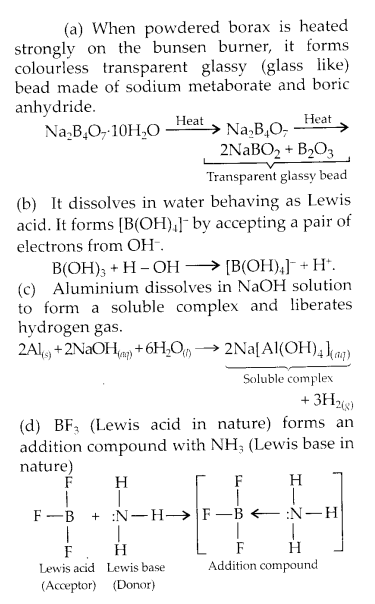
NCERT Solutions for Class 11 Chemistry Chapter 11, Question 20.
(a) Borax is heated strongly.
(b) Boric acid is added to water.
(c) Aluminium is treated with dilute NaOFI.
(d) BF3 is reacted with ammonia.
Solution.
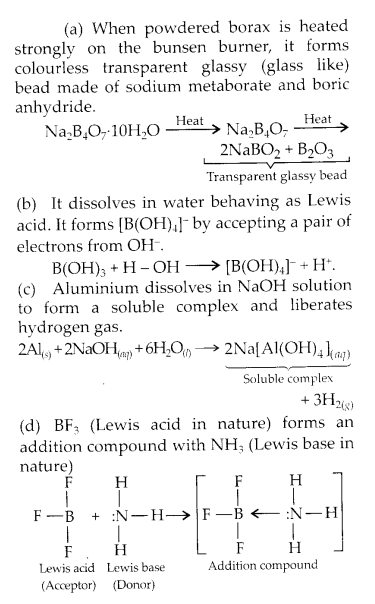
NCERT Solutions for Class 11 Chemistry Chapter 11, Question 21.
(a) Silicon is heated with methyl chloride at high temperature in the presence of copper;
(b) Silicon dioxide is treated with hydrogen fluoride;
(c) CO is heated with ZnO;
(d) Hydrated alumina is treated with aqueous NaOH solution.
Solution.
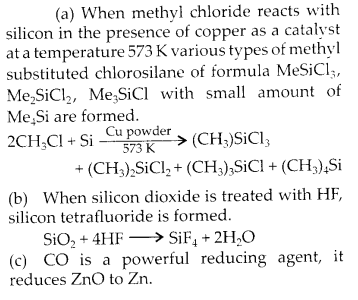

NCERT Solutions for Class 11 Chemistry Chapter 11, Question 22.
(i) Conc. HNO3 can be transported in aluminium container.
(ii) A mixture of dilute NaOH and aluminium pieces is used to open drain.
(iii) Graphite is used as lubricant.
(iv) Diamond is used as an abrasive.
(v) Aluminium alloys are used to make aircraft body.
(vi) Aluminium utensils should not be kept in water overnight.
(vii) Aluminium wire is used to make transmission cables.
Solution.
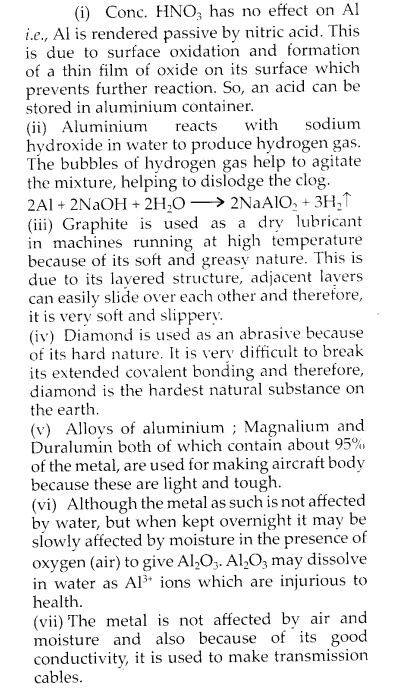
NCERT Solutions for Class 11 Chemistry Chapter 11, Question 23.
Solution.
Large decrease in ionisation potential from C to Si is due to increase in size of the atom and shielding effect.NCERT Solutions for Class 11 Chemistry Chapter 11, Question 24.
Solution.
This can be understood from the variation in the inner core of the electronic configuration. The presence of additional 10 d-electrons offer only poor screening effect for the outer electron from the increased nuclear charge in gallium. Consequently, the atomic radius of gallium (135 pm) is less than that of aluminium (143 pm).NCERT Solutions for Class 11 Chemistry Chapter 11, Question 25.
Solution.
The property due to which an element exists in two or more forms which differ in their physical and some of the chemical properties is known as allotropy and the various forms are called allotropes or allotropic modifications. Carbon exists in two allotropic forms crystalline and amorphous. The crystalline forms are diamond and graphite.
Diamond due to extended covalent bonding is the hardest natural substance on the earth.
with Al2(SO4)3 which is soluble in Water.
NCERT Solutions for Class 11 Chemistry Chapter 11, Question 26.

Solution.
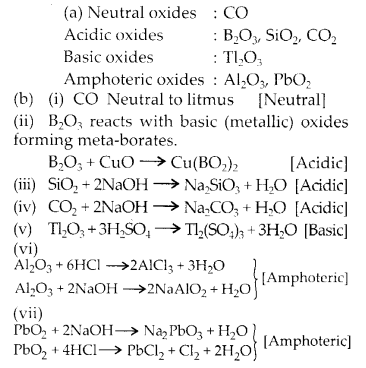
NCERT Solutions for Class 11 Chemistry Chapter 11, Question 27.
Solution.
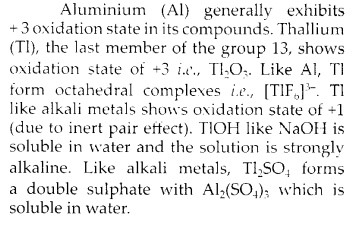
NCERT Solutions for Class 11 Chemistry Chapter 11, Question 28.
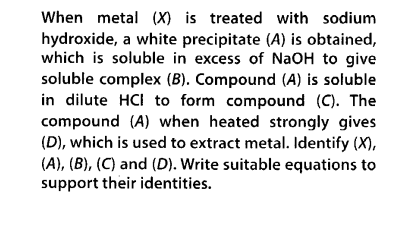
Solution.
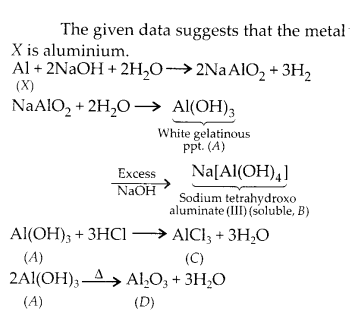
NCERT Solutions for Class 11 Chemistry Chapter 11, Question 29.
(a) inert pair effect
(b) allotropy and
(c) catenation?
Solution.
(a) Inert pair effect : The reluctance of ns2 pair in p-block elements having higher atomic number to take part in bond formation is called inert pair effect.(b) Allotropy : The existence of an element in more than one form having different physical properties but same or slightly different chemical properties is called allotropy.
(c) Catenation : The property by virtue of which a large number of atoms of the same element get linked together through covalent bonds resulting in the formation of long chains, branched chains and rings of different sizes is called catenation.
NCERT Solutions for Class 11 Chemistry Chapter 11, Question 30.
(i) Its aqueous solution is alkaline to litmus.
(ii) It swells up to a glassy material Yon strong heating.
(iii) When conc. H2SO4 is added to a hot solution of X, white crystal of acid Z separates out.
Write equations for all the above reactions and identify X, Y and Z.
Solution.
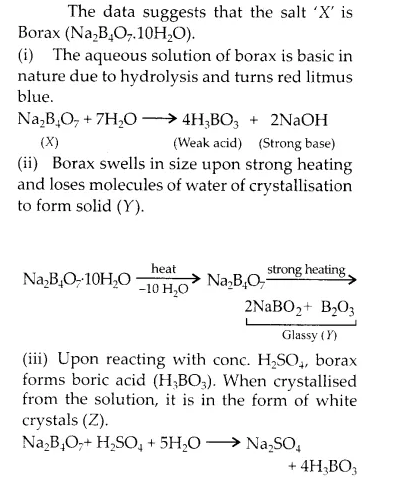
NCERT Solutions for Class 11 Chemistry Chapter 11, Question 31.

Solution.
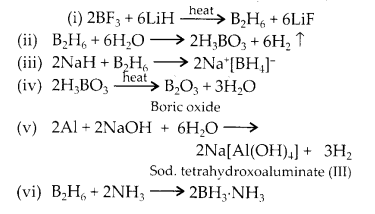
NCERT Solutions for Class 11 Chemistry Chapter 11, Question 32.
Solution.
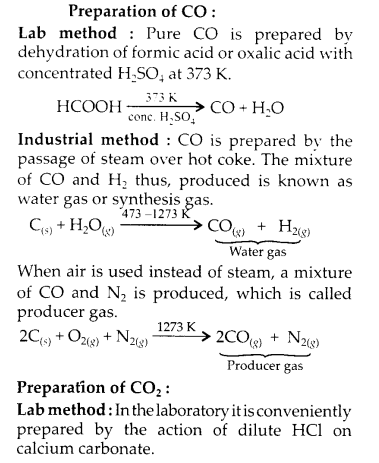
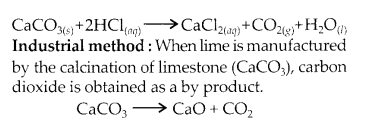
NCERT Solutions for Class 11 Chemistry Chapter 11, Question 33.
(a) neutral
(b) amphoteric
(c) basic
(d) acidic.
Solution.

NCERT Solutions for Class 11 Chemistry Chapter 11, Question 34.
(a) its acidic nature
(b) the presence of hydrogen bonds
(c) its monobasic nature
(d) its geometry.
Solution.
(b) the presence of hydrogen bondsNCERT Solutions for Class 11 Chemistry Chapter 11, Question 35.
(a) sp
(b) sp2
(c) sp3
(d) dsp2
Solution.
(c) sp3NCERT Solutions for Class 11 Chemistry Chapter 11, Question 36.
(a) diamond
(b) graphite
(c) fullerenes
(d) coal
Solution.
(b) : Graphite is thermodynamically more stable than diamond and its free energy of formation is 1.9 kJ mol-1 less than diamond.NCERT Solutions for Class 11 Chemistry Chapter 11, Question 37.
(a) exhibit oxidation state of +4 only
(b) exhibit oxidation state of +2 and +4
(c) form M2- and M4+ ions
(d) form M2+ and M4+ ions.
Solution.
(b, d): The group 14 elements have four electrons in outermost shell. The common oxidation states exhibited by these elements are +4 and +2.Elements like Sn and Pb are metallic thus, form M2+ and M4+ ions.
NCERT Solutions for Class 11 Chemistry Chapter 11, Question 38.
Solution.

NCERT Class 11 Chemistry
Class 11 Chemistry Chapters | Chemistry Class 11 Chapter 11
Chapterwise NCERT Solutions for Class 11 Chemistry
-
NCERT Solutions For Class 11 Chemistry Chapter 1 Some Basic Concepts of Chemistry
NCERT Solutions For Class 11 Chemistry Chapter 2 Structure of The Atom
NCERT Solutions For Class 11 Chemistry Chapter 3 Classification of Elements and Periodicity in Properties
NCERT Solutions For Class 11 Chemistry Chapter 4 Chemical Bonding and Molecular Structure
NCERT Solutions For Class 11 Chemistry Chapter 5 States of Matter
NCERT Solutions For Class 11 Chemistry Chapter 6 Thermodynamics
NCERT Solutions For Class 11 Chemistry Chapter 7 Equilibrium
NCERT Solutions For Class 11 Chemistry Chapter 8 Redox Reactions
NCERT Solutions For Class 11 Chemistry Chapter 9 Hydrogen
NCERT Solutions For Class 11 Chemistry Chapter 10 The sBlock Elements
NCERT Solutions For Class 11 Chemistry Chapter 11 The pBlock Elements
NCERT Solutions For Class 11 Chemistry Chapter 12 Organic Chemistry: Some Basic Principles and Techniques
NCERT Solutions For Class 11 Chemistry Chapter 13 Hydrocarbons
NCERT Solutions For Class 11 Chemistry Chapter 14 Environmental Chemistry
| NCERT Solutions for Class 12 All Subjects | NCERT Solutions for Class 10 All Subjects |
| NCERT Solutions for Class 11 All Subjects | NCERT Solutions for Class 9 All Subjects |

Post a Comment
इस पेज / वेबसाइट की त्रुटियों / गलतियों को यहाँ दर्ज कीजिये
(Errors/mistakes on this page/website enter here)